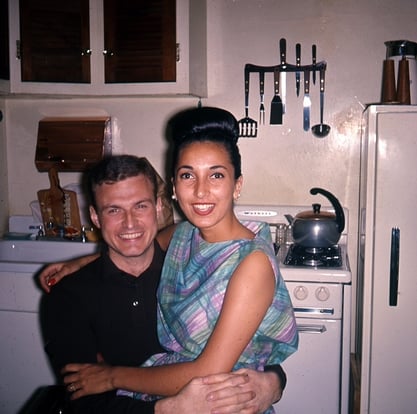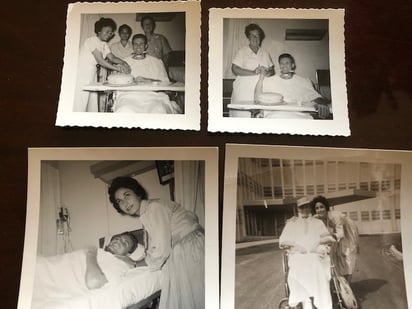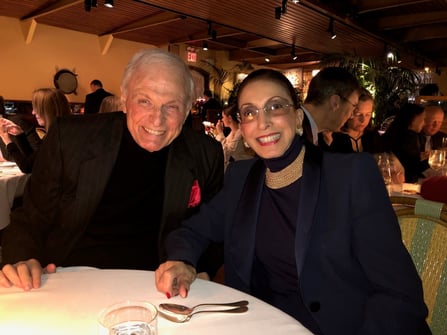When an accident fails to derail the sweetest of love stories.
Lorraine DiPaolo says the beaches should have been closed on that bright summer day in 1960 when her husband-to-be, 26-year-old Gordon DiPaolo, decided to take a swim at Jacob Reis beach on his way back from a business meeting at Revlon, where he worked. He got caught in the undertow, rolled with it and landed on a rock cracking his neck.

"Rescue workers resuscitated him on the beach and transferred him to a local hospital," Lorraine says. "Gordon was paralyzed from the neck down, a quadriplegic, and I was determined to remain by his side through all of it."
In an experimental procedure, doctors took a bone slug from Gordon's hip and wedged it between the broken cervical, between C5 and C6. Slowly, he started to move. First a finger, then a toe. Gordon spent two years as an inpatient at St. Vincent's Hospital in New York. During that time, he recovered to the point of standing, then walking with braces in parallel bars. He was even able to drive a car with hand controls.
"He worked so hard," Lorraine says, "and he was so willing to do anything that was asked of him." A few days after doctors discharged Gordon in 1962, he married Lorraine, then only 22, and they moved into a retrofitted apartment in Brooklyn that was completely accessible for Gordon. What to do next? He decided to go back to school to achieve his Masters and Ph.D. in International Finance. He studied, and Lorraine worked hard at New York University Graduate School of Business.
People still ask Lorraine, "Did you have one second of doubt?" Her answer is simple: "Absolutely not." She was young and in love, and she was strong. She knew that being with Gordon meant helping him with everyday chores; getting dressed, showering, and personal hygiene. "I put my blinders on and just plowed ahead," she says.
 The pair met at Arthur Murray dance studio, where Lorraine had applied to be a dance instructor. Gordon, a former football player, also worked for Arthur Murray, and he taught Lorraine how to instruct students on the tango, mambo and cha-cha-cha. The two hit it off.
The pair met at Arthur Murray dance studio, where Lorraine had applied to be a dance instructor. Gordon, a former football player, also worked for Arthur Murray, and he taught Lorraine how to instruct students on the tango, mambo and cha-cha-cha. The two hit it off.
After graduation, Gordon accepted a position as a college professor at St. John's University, where he taught for a couple of years before joining the College of Staten Island, where he taught for more than 50 years, ultimately becoming Chair of Management in the Business Department. Lorraine was working as a stockbroker on Wall Street. They were making it work.
But one day before he started his first teaching job at St. John's, he told Lorraine that he couldn't go on. He couldn't live his life in a chair, unable to play football, dance with his wife, run in a park. "I remained calm, said I understood, and then, firmly and quietly, I said, 'I gave you years of my life because of my undying love for you, so now, you owe me,'" Lorraine says. "I told him to give me one year of teaching, and if he felt the same way at the end of that year, I wouldn't stand in his way."
The year came and went, and the pair never broached the subject again. Instead, Gordon and Lorraine built a full life together. They both loved cabarets, good restaurants and the company of engaging friends. They traveled to European towns in the springtime, spent winter breaks in Puerto Rico and the Caribbean and gambled in Las Vegas. They even took an annual sojourn to a chateau in Provence.
"Gordon was knowledgeable, inquisitive, humorous and charismatic," Lorraine says. "I never saw the wheelchair; just the fabulous man I married."
But in 2009, Gordon suffered another blow when his wheelchair slipped as his buddies were transporting him down a couple of steps. "He landed on his neck in the same spot as the original injury," Lorraine says. Now 75 years old, Gordon's recovery was more challenging. He could no longer stand with the aid of crutches, or drive a car, and his dexterity was impaired.
 Even though Gordon was back in the hospital fighting old battles, he maintained his radiant smile and stalwart perseverance. And with the help of a driver, he kept up a steady work pace at work.
Even though Gordon was back in the hospital fighting old battles, he maintained his radiant smile and stalwart perseverance. And with the help of a driver, he kept up a steady work pace at work.
"In the annals of modern medicine, he was a medical miracle," Lorraine says. "He spent 60 years in a wheelchair without any health problems — no high blood pressure, low blood pressure, diabetes or cancers." His primary struggle was the wounds that developed from spending so much time sitting in the chair, something Lorraine became a pro at managing.
But over time, Gordon's injuries began to take a toll. Though he continued working at the College of Staten Island until the week before he died, he began to lose strength, particularly in his hands. "He told me he could no longer hold a pen or open the refrigerator door," Lorraine says. “He tidied his office, cleaned up his computer and gave me instructions to donate his body to science." It was time.
On February 28, 2020, Lorraine played soft Latin jazz music for Gordon, the same tunes they danced to during their Arthur Murray days, and asked him to imagine the end of their day at the dance studio. "The dance floor is empty. The music is playing just for us," she whispered. Hours later, Gordon passed away with Lorraine lying beside him.


 The pair met at Arthur Murray dance studio, where Lorraine had applied to be a dance instructor. Gordon, a former football player, also worked for Arthur Murray, and he taught Lorraine how to instruct students on the tango, mambo and cha-cha-cha. The two hit it off.
The pair met at Arthur Murray dance studio, where Lorraine had applied to be a dance instructor. Gordon, a former football player, also worked for Arthur Murray, and he taught Lorraine how to instruct students on the tango, mambo and cha-cha-cha. The two hit it off. Even though Gordon was back in the hospital fighting old battles, he maintained his radiant smile and stalwart perseverance. And with the help of a driver, he kept up a steady work pace at work.
Even though Gordon was back in the hospital fighting old battles, he maintained his radiant smile and stalwart perseverance. And with the help of a driver, he kept up a steady work pace at work.